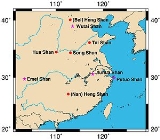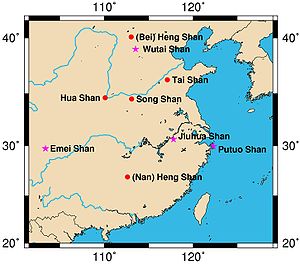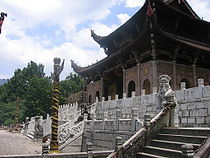
Sacred Mountains of China
Encyclopedia
The Sacred Mountains of China are divided into two groups, one associated with Taoism
and the other with Buddhism
. The group associated with Taoism is known as the Five Great Mountains , whereas the group associated with Buddhism is referred to as the Four Sacred Mountains of Buddhism .
The sacred mountains of both groups have been important destinations for pilgrimage
, the Chinese expression for pilgrimage is a shortened version of an expression which means "paying respect to a holy mountain" .

, which includes the center as a direction:
East Great Mountain (Dōngyuè): Tài Shān
; "Tranquil Mountain", Shāndōng Province
, 1,545 m, 36°15′N 117°06′E
West Great Mountain (Xīyuè): Huà Shān
; "Splendid Mountain",
Shănxī Province
, 1,997 m 34°29′N 110°05′E
South Great Mountain (Nányuè): Héng Shān (Hunan)
; "Balancing Mountain", Húnán Province
, 1,290 m, 27.254798°N 112.655743°E
North Great Mountain (Běiyuè): Héng Shān
; "Permanent Mountain", Shānxī Province
, 2,017 m, 39°40′26"N 113°44′08"E
Center Great Mountain (Zhōngyuè): Sōng Shān
; "Lofty Mountain", Hénán Province
, 1,494 m, 34°29′5"N 112°57′37"E
Alternatively, these mountains are sometimes referred to by the respective directions, i.e., as the "Northern Great Mountain" (北嶽/北岳 Běi Yuè), "Southern Great Mountain" (南嶽/南岳 Nán Yuè), "Eastern Great Mountain" (東嶽/东岳 Dōng Yuè), "Western Great Mountain" (西嶽/西岳 Xī Yuè), and "Central Great Mountain" (中嶽/中岳 Zhōng Yuè).
According to Chinese mythology, the Five Great Mountains originated from the body of Pangu
(盤古/盘古 Pángǔ), the first being and the creator of the world. Because of its eastern location, Mount Tài is associated with the rising sun which signifies birth and renewal. Due to this interpretation, it is often regarded as the most sacred of the Five Great Mountains. In accordance with its special position, Mount Tài is believed to have been formed out of Pangu's head. Mount Heng in Hunan is believed to be a remainder of Pangu's right arm, Mount Heng in Shanxi of his left arm, Mount Song of his belly, and Mount Hua of his feet.
 The Buddhist Four Sacred Mountains in China are:
The Buddhist Four Sacred Mountains in China are:
Wǔtái Shān
; "Five-Platform Mountain", Shānxī Province
, 3,058 m,
39°04′45"N 113°33′53"E
Wutai is the home of the Bodhisattva
of wisdom, Manjusri
or Wenshu (Traditional: 文殊) in Chinese.
, 3,099 m, 29°31′11"N 103°19′57"E
The patron bodhisattva
of Emei is Samantabhadra
, known in Chinese as Puxian (普贤菩萨).
Jiǔhuá Shān
; "Nine Glories Mountain", Ānhuī Province
, 1,341 m, 30°28′56"N 117°48′16"E
Many of the mountain's shrines and temples are dedicated to Ksitigarbha
(known in Chinese as Dìzàng, , in Japanese as Jizō), who is a bodhisattva
and protector of beings in hell realms
", Zhèjiāng Province
, 284 m
30°00′35"N 122°23′06"E
This mountain is considered the bodhimanda
of Avalokitesvara
(Guan Yin), bodhisattva of compassion.
Wǔdāng Shān
; northwestern part of Hubei
. Main peak: 1612m. 32°40′0"N 111°00′4"E.
Lónghŭ Shān
Simplified Chinese: 龙虎山; Traditional Chinese: 龍虎山; literally "Dragon Tiger Mountain", Jiangxi
. Main peak: 247.4m.
Qíyūn Shān
; literally "As High as the Clouds", Anhui
. Main peak: 585m.
Qīngchéng Shān
; Dujiangyan, Sichuan
. Main peak: 1260m (surveyed in 2007). famous for "The most secluded place in China". 31°01′07.63"N 103°32′47.36"E.
Taoism
Taoism refers to a philosophical or religious tradition in which the basic concept is to establish harmony with the Tao , which is the mechanism of everything that exists...
and the other with Buddhism
Buddhism
Buddhism is a religion and philosophy encompassing a variety of traditions, beliefs and practices, largely based on teachings attributed to Siddhartha Gautama, commonly known as the Buddha . The Buddha lived and taught in the northeastern Indian subcontinent some time between the 6th and 4th...
. The group associated with Taoism is known as the Five Great Mountains , whereas the group associated with Buddhism is referred to as the Four Sacred Mountains of Buddhism .
The sacred mountains of both groups have been important destinations for pilgrimage
Pilgrimage
A pilgrimage is a journey or search of great moral or spiritual significance. Typically, it is a journey to a shrine or other location of importance to a person's beliefs and faith...
, the Chinese expression for pilgrimage is a shortened version of an expression which means "paying respect to a holy mountain" .

The Five Great Mountains
The Taoist Five Great Mountains are arranged according to the five cardinal directions of Chinese geomancyGeomancy
Geomancy is a method of divination that interprets markings on the ground or the patterns formed by tossed handfuls of soil, rocks, or sand...
, which includes the center as a direction:
East Great Mountain (Dōngyuè): Tài ShānMount TaiMount Tai is a mountain of historical and cultural significance located north of the city of Tai'an, in Shandong province, People's Republic of China. The tallest peak is the Jade Emperor Peak , which is commonly reported as tall, but is described by the PRC government as .Mount Tai is one of the...
; "Tranquil Mountain", Shāndōng ProvinceShandong
' is a Province located on the eastern coast of the People's Republic of China. Shandong has played a major role in Chinese history from the beginning of Chinese civilization along the lower reaches of the Yellow River and served as a pivotal cultural and religious site for Taoism, Chinese...
, 1,545 m, 36°15′N 117°06′E
West Great Mountain (Xīyuè): Huà ShānMount HuaMount Hua or Hua Shan in Chinese is located in Shaanxi Province, about 120 kilometres east of the city of Xi'an, near the city Huayin in China. Also known as Xiyuè, Western Great Mountain, it is one of China's Five Sacred Taoist Mountains, and has a long history of religious significance...
; "Splendid Mountain",Shănxī Province
Shaanxi
' is a province in the central part of Mainland China, and it includes portions of the Loess Plateau on the middle reaches of the Yellow River in addition to the Qinling Mountains across the southern part of this province...
, 1,997 m 34°29′N 110°05′E
South Great Mountain (Nányuè): Héng Shān (Hunan)Mount Heng (Hunan)Mount Heng , also known as Nan Yue , is located in Hunan Province, People's Republic of China and is one of the Five Sacred Mountains of Taoism in China. Heng Shan is a mountain range long with 72 peaks and lies at 27.254798°N and 112.655743°E...
; "Balancing Mountain", Húnán ProvinceHunan
' is a province of South-Central China, located to the south of the middle reaches of the Yangtze River and south of Lake Dongting...
, 1,290 m, 27.254798°N 112.655743°E
North Great Mountain (Běiyuè): Héng ShānMount Heng (Shanxi)Heng Shan or Heng Mountain in Shanxi Province is one of the Five Sacred Mountains of Taoism. At 2,017 m, it is one of the five tallest peaks in China Proper. Heng Shan in Shanxi Province is sometimes known as the Northern Heng Shan, and the one in Hunan Province as Southern Heng Shan...
; "Permanent Mountain", Shānxī ProvinceShanxi
' is a province in Northern China. Its one-character abbreviation is "晋" , after the state of Jin that existed here during the Spring and Autumn Period....
, 2,017 m, 39°40′26"N 113°44′08"E
Center Great Mountain (Zhōngyuè): Sōng ShānMount SongMount Song, known in Chinese as Song Shan , is one of the Five Sacred Mountains of Taoism and is located in Henan province on the south bank of the Yellow River in China...
; "Lofty Mountain", Hénán ProvinceHenan
Henan , is a province of the People's Republic of China, located in the central part of the country. Its one-character abbreviation is "豫" , named after Yuzhou , a Han Dynasty state that included parts of Henan...
, 1,494 m, 34°29′5"N 112°57′37"E
Alternatively, these mountains are sometimes referred to by the respective directions, i.e., as the "Northern Great Mountain" (北嶽/北岳 Běi Yuè), "Southern Great Mountain" (南嶽/南岳 Nán Yuè), "Eastern Great Mountain" (東嶽/东岳 Dōng Yuè), "Western Great Mountain" (西嶽/西岳 Xī Yuè), and "Central Great Mountain" (中嶽/中岳 Zhōng Yuè).
According to Chinese mythology, the Five Great Mountains originated from the body of Pangu
Pangu
Pangu was the first living being and the creator of all in Chinese mythology.- The Pangu legend:...
(盤古/盘古 Pángǔ), the first being and the creator of the world. Because of its eastern location, Mount Tài is associated with the rising sun which signifies birth and renewal. Due to this interpretation, it is often regarded as the most sacred of the Five Great Mountains. In accordance with its special position, Mount Tài is believed to have been formed out of Pangu's head. Mount Heng in Hunan is believed to be a remainder of Pangu's right arm, Mount Heng in Shanxi of his left arm, Mount Song of his belly, and Mount Hua of his feet.
The Four Sacred Mountains of Buddhism

Wǔtái ShānWutai ShanMount Wutai , also known as Wutai Mountain or Qingliang Shan, is located in Shanxi, China. The mountain is home to many of China's most important monasteries and temples...
; "Five-Platform Mountain", Shānxī ProvinceShanxi
' is a province in Northern China. Its one-character abbreviation is "晋" , after the state of Jin that existed here during the Spring and Autumn Period....
, 3,058 m,
39°04′45"N 113°33′53"E
Wutai is the home of the Bodhisattva
Bodhisattva
In Buddhism, a bodhisattva is either an enlightened existence or an enlightenment-being or, given the variant Sanskrit spelling satva rather than sattva, "heroic-minded one for enlightenment ." The Pali term has sometimes been translated as "wisdom-being," although in modern publications, and...
of wisdom, Manjusri
Manjusri
Mañjuśrī is a bodhisattva associated with transcendent wisdom in Mahāyāna Buddhism. In Esoteric Buddhism he is also taken as a meditational deity. The Sanskrit name Mañjuśrī can be translated as "Gentle Glory"...
or Wenshu (Traditional: 文殊) in Chinese.
Éméi Shān
; "High and Lofty Mountain", Sìchuān ProvinceSichuan
' , known formerly in the West by its postal map spellings of Szechwan or Szechuan is a province in Southwest China with its capital in Chengdu...
, 3,099 m, 29°31′11"N 103°19′57"E
The patron bodhisattva
Bodhisattva
In Buddhism, a bodhisattva is either an enlightened existence or an enlightenment-being or, given the variant Sanskrit spelling satva rather than sattva, "heroic-minded one for enlightenment ." The Pali term has sometimes been translated as "wisdom-being," although in modern publications, and...
of Emei is Samantabhadra
Samantabhadra
Samantabhadra , is a bodhisattva in Mahayana Buddhism associated with Buddhist practice and meditation. Together with Shakyamuni Buddha and fellow bodhisattva Manjusri he forms the Shakyamuni trinity in Buddhism...
, known in Chinese as Puxian (普贤菩萨).
Jiǔhuá ShānJiuhuashanMount Jiuhua is one of the four sacred mountains of Chinese Buddhism. It is located in Qingyang County in Anhui province and is famous for its rich landscape and ancient temples....
; "Nine Glories Mountain", Ānhuī ProvinceAnhui
Anhui is a province in the People's Republic of China. Located in eastern China across the basins of the Yangtze River and the Huai River, it borders Jiangsu to the east, Zhejiang to the southeast, Jiangxi to the south, Hubei to the southwest, Henan to the northwest, and Shandong for a tiny...
, 1,341 m, 30°28′56"N 117°48′16"E
Many of the mountain's shrines and temples are dedicated to Ksitigarbha
Ksitigarbha
Ksitigarbha is a bodhisattva primarily revered in East Asian Buddhism, usually depicted as a Buddhist monk in the Orient. The name may be translated as "Earth Treasury", "Earth Store", "Earth Matrix", or "Earth Womb"...
(known in Chinese as Dìzàng, , in Japanese as Jizō), who is a bodhisattva
Bodhisattva
In Buddhism, a bodhisattva is either an enlightened existence or an enlightenment-being or, given the variant Sanskrit spelling satva rather than sattva, "heroic-minded one for enlightenment ." The Pali term has sometimes been translated as "wisdom-being," although in modern publications, and...
and protector of beings in hell realms
Naraka (Buddhism)
Naraka नरक or Niraya निरय is the name given to one of the worlds of greatest suffering in Buddhist cosmology.Naraka is usually translated into English as "hell", "hell realm", or "purgatory"...
Pǔtuó Shān
; "Mount PotalakaMount Potalaka
Mount Potalaka , which means "Brilliance", is the mythical dwelling of the Buddhist figure Avalokitesvara, said to exist in the seas south of India. The mountain is first mentioned in the final chapter of the Flower Garland Sutra, the Gandavyuha Sutra, where the chapter's protagonist journeys to...
", Zhèjiāng Province
Zhejiang
Zhejiang is an eastern coastal province of the People's Republic of China. The word Zhejiang was the old name of the Qiantang River, which passes through Hangzhou, the provincial capital...
, 284 m
30°00′35"N 122°23′06"E
This mountain is considered the bodhimanda
Bodhimaṇḍa
Bodhimaṇḍa is a term used in Buddhism meaning the "position of awakening." According to Haribhadra, it is "a place used as a seat, where the essence of enlightenment is present." Although spelled similarly, a bodhimaṇḍa is not synonymous with a bodhimaṇḍala, which is a "circle of...
of Avalokitesvara
Avalokitesvara
Avalokiteśvara is a bodhisattva who embodies the compassion of all Buddhas. He is one of the more widely revered bodhisattvas in mainstream Mahayana Buddhism....
(Guan Yin), bodhisattva of compassion.
Wǔdāng ShānWudang MountainsThe Wudang Mountains , also known as Wu Tang Shan or simply Wudang, are a small mountain range in the northwestern part of Hubei Province of People's Republic of China, just to the south of the city of Shiyan.-Geography:...
; northwestern part of HubeiHubei
' Hupeh) is a province in Central China. The name of the province means "north of the lake", referring to its position north of Lake Dongting...
. Main peak: 1612m. 32°40′0"N 111°00′4"E.
Lónghŭ ShānMount LonghuMount Longhu , is located in Jiangxi, China. It is famous for being one of the birthplaces of Taoism, with many Taoist temples built upon the mountainside...
Simplified Chinese: 龙虎山; Traditional Chinese: 龍虎山; literally "Dragon Tiger Mountain", JiangxiJiangxi
' is a southern province in the People's Republic of China. Spanning from the banks of the Yangtze River in the north into hillier areas in the south, it shares a border with Anhui to the north, Zhejiang to the northeast, Fujian to the east, Guangdong to the south, Hunan to the west, and Hubei to...
. Main peak: 247.4m.
Qíyūn ShānMount QiyunMount Qiyun, is a mountain located in Qingyang County, Anhui Province, People's Republic of China. A Chinese National Park, it lies some to the west of Huangshan City and is sacred to Taoists. The mountain is also called "Landform of the Rosy Clouds" due to the red conglomerate and sandstone of...
; literally "As High as the Clouds", AnhuiAnhui
Anhui is a province in the People's Republic of China. Located in eastern China across the basins of the Yangtze River and the Huai River, it borders Jiangsu to the east, Zhejiang to the southeast, Jiangxi to the south, Hubei to the southwest, Henan to the northwest, and Shandong for a tiny...
. Main peak: 585m.
Qīngchéng ShānMount QingchengMount Qingcheng is a mountain in Dujiangyan, Sichuan, China. It is amongst the most important centres of Taoism in China. In Taoism mythology, it was the site of the Yellow Emperor's studies with Ning Fengzhi. As a centre of the Daoist religion it became host to many temples. The mountain has 36...
; Dujiangyan, SichuanSichuan
' , known formerly in the West by its postal map spellings of Szechwan or Szechuan is a province in Southwest China with its capital in Chengdu...
. Main peak: 1260m (surveyed in 2007). famous for "The most secluded place in China". 31°01′07.63"N 103°32′47.36"E.

